If you want to prevent the spread of bed bugs…
It’s important to properly identify them first.
Bed bugs resemble several other types of bugs due to their familiar insectoid appearance and their small size.
If you’re looking for bed bugs, these pests are characterized by their red/brown color, apple seed-sized body, and lack of body segmentation.
Certain other bugs will look similar, but there are specific differences you can find by looking closer.
Here is a list of 13 types of bugs that look like bed bugs.
- Bat Bugs
- Booklice
- Spider Beetles
- Fleas
- Carpet Beetles
- Cockroach Nymphs
- Ticks
- Swallow Bugs
- Head Lice
- Mites
- Termites
- Minute Pirate Bugs
- Flour Beetles
1. Bat Bugs
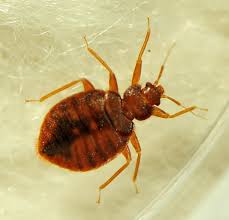
Bat bugs, apart from sharing a similar name to bed bugs, look the most like bed bugs compared with any other insect. The only discernible difference in their appearance is the longer hairs on a bat bug’s head.
Otherwise, they’re brown, oval in shape, the size of a small seed, and cannot fly despite possessing wing pads.
(All of which are traits bed bugs share).
However, you won’t likely find bat bugs in your bedroom. Instead, as the name would suggest, bat bugs tend to feed on bats and reside in caves or other areas where bats are prevalent.
2. Booklice
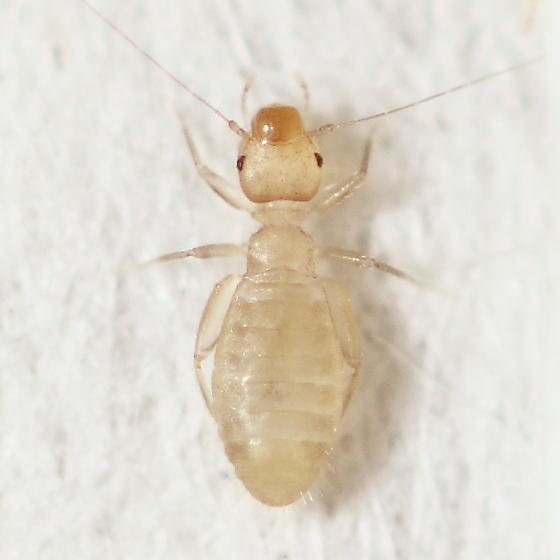
Booklice stand apart from bed bugs mainly in their shape, which is longer and thinner like a termite’s, with equally long and thin antennae.
They can reach sizes of 1 to 6mm in length. Their bodies are also softer than bed bugs, making them easier to kill.
Booklice have a distinct color that is light brown, or some would say a creamy yellow.
Their heads and bodies are visibly segmented unlike bed bugs, and some have wings capable of flight.
These bugs don’t bite, though when dead, their bodies could combine with dust to aggravate asthma attacks.
Unlike bat bugs, you do have a chance of finding booklice near your bed, as they often appear in areas of high humidity due to their susceptibility to dehydration.
3. Spider Beetles
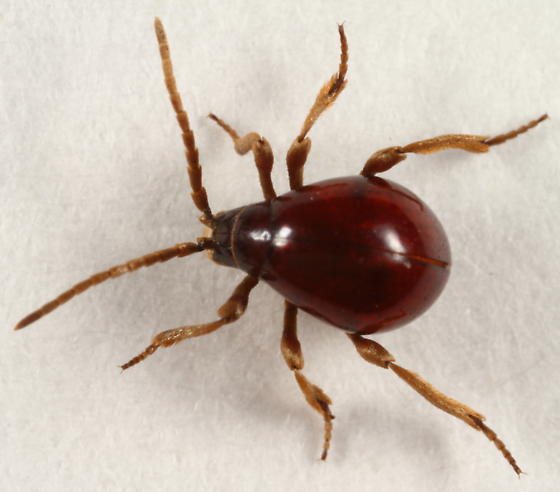
Spider beetles somewhat resemble bed bugs in their round oval shape and 1 to 5mm size, but it’s relatively easy to tell these insects apart from bed bugs if you look closely enough.
Spider beetles are red-brown, or almost black, with long legs and antennae. Their bodies are also covered in hair, with a head that’s directly connected to their body.
Like booklice, some species of spider beetles can fly (and they don’t bite).
These beetles tend to hang out in wooden structures where they’re likely to find food. You might experience an infestation of spider beetles if your residence is poorly maintained, but they don’t pose the same health risks as bed bugs.
4. Fleas

In terms of their ability to cause extreme irritation, fleas are very similar to bed bugs.
On the other hand, they’re easy to tell apart from other insects. Fleas are reddish-brown, but they possess long legs and round heads, which often feature similar traits to the Cat Flea Species.
Fleas are about an 8th of an inch long and flat. Their ability to jump can make them difficult to catch.
Unlike bed bugs, an infestation of fleas typically occurs because your pet brought them into your home from outside.
5. Carpet Beetles
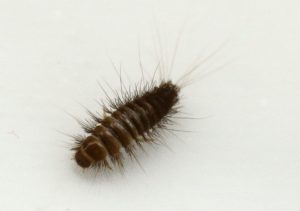
At first glance, you might mistake a carpet beetle for the alarming oval body of a bed bug, but this is another type of insect you can identify upon closer inspection.
Carpet beetles feature a black-and-white pattern with orange or red scales. Their heads are small and mostly hidden when looking from above.
They’re around 2 to 3.8mm long and adults can fly. The only harm they cause to humans is dermatitis resulting from allergic reactions.
Carpet beetles appear on flowers and occasionally on carpeting, but they won’t normally venture to your bed.
At the worst…
They might get into your house and carpeting if you bring in some fresh-cut flowers.
Each of these bugs is relatively easy to identify if you know what to look for, enabling you to determine whether you’re infested with bed bugs or another type of pest.
6. Cockroach Nymphs

Not many people are familiar with the life cycle of Cockroaches, but it all begins with an egg. Once the egg hatches, the immature cockroach is known as a nymph, or baby cockroach.
Nymphs are bright white in color initially, and they harden and darken within a few hours.
Interesting Fact: The availability of food for cockroach nymphs within the first 10 hours has a substantial effect on the chances of their long-term survival.
German cockroach nymphs are typically less than 3mm long when they hatch. Once they darken, they are almost uniformly dark, with just a single light patch located on the back.
These insects can be found in similar ways as bed bugs, and can often be confused for bed bugs at first glance.
7. Ticks

If you spend time outdoors or have pets, you need to be aware of ticks.
Similar to bed bugs, Ticks feast on human blood.
The main difference is that Ticks are known to transmit infectious diseases.
Some diseases you can get from tick bites include:
- Lyme Disease
- Rocky Mountain Spotted Fever
- Ehrlichiosis
Ticks are very small and can be difficult to see. They can easily attach to you if you walk through dense woods where bad infestations exist. They most commonly stick to you if you walk through leaves, shrubs, or tall grass.
To help protect your body from both ticks and bed bugs you should do the following:
- Wear light-colored, protective clothing.
- Tuck pant legs into socks.
- Avoid areas of infestation.
- Check yourself on occasion for any presence of insects.
8. Swallow Bugs
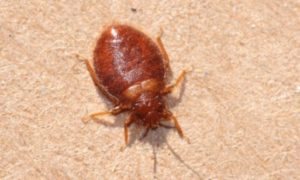
The physical traits of swallow bugs and bed bugs are extremely similar, but the swallow bug is distinguished by its antenna. It also tends to have a grayish-brown color rather than the reddish-brown of the common bed bug.
It’s unlikely you will come across these creatures as they are typically found in barns and cliff swallow nests. There are cases, however, where they readily invade human structures and can bite people as well.
Swallow bugs are known for breeding through the summer, and early fall when the birds depart.
One thing that sets them apart is their bites can cause minor to severe reactions in humans.
Interesting Fact: Swallow Bugs have the special ability to survive up to 3 years without food.
9. Head Lice
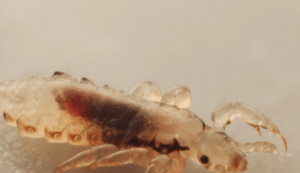
Adult head lice are about 2 to 3 mm long, and typically infest the head and neck. Similar to bed bugs, lice move by crawling, but they cannot hop or fly.
They also spread rapidly, and often if one is sighted, it means that an infestation is present.
The adult louse is about the size of a sesame seed, has 6 legs, and is tan to grayish-white. Females are usually larger than males and can lay up to 8 eggs per day.
Adult lice can live up to 30 days on a person’s head, and they are much more food-dependent. For lice to survive they must feed daily, as without meals…
The lice will die in 1 or 2 days.
10. Mites
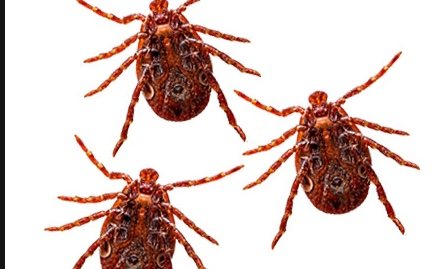
Technically “Mites” can describe a number of organisms within the arthropod family. While these creatures are mostly related to ticks, they resemble bed bugs in many ways.
Similar to bed bugs, these creatures lack wings and are quite small. Most people don’t notice they have been exposed to mites until they discover the small bites on their skin.
Luckily mite bites are mostly harmless, but they can sometimes lead to some irritation and mild swelling.
Though bed bug bites can be identified by distinct linear or zig-zag shapes, mite bites are harder to pinpoint. These bites will vary in shape, size, and pattern depending on the bite.
11. Termites
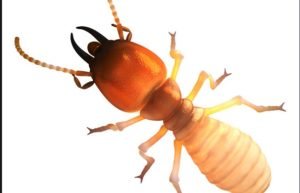
Termites are one of the more unique indoor pests. These creatures are often called “silent destroyers” in that they can be devastating to your home or property.
Other than their shape and size, termites differ from bed bugs by their food source.
Unlike human blood, termites feed on dead plants and trees. They get their nutrients from cellulose, an organic fiber found in wood. Though wood makes up the majority of their diet, they can also eat paper, plastic, and drywall.
Though termites and bed bugs can sometimes be hard to distinguish with the naked eye, it’s unlikely you’ll have to make that distinction.
While bed bugs come out of hiding in order to feed, termites are not usually found by accident. Since termites rarely emerge from food sources, you probably won’t know you have an infestation until you come across damage during construction or an interior remodeling project.
12. Minute Pirate Bugs

Known as flower bugs (Orius species), Minute Pirate Bugs are found all over the United States, and there are more than 500 species globally. During the warmer months, they are mostly eating other smaller insects like the following:
- Mites
- Thrips
- Aphids
- Whiteflies
- And other very small insects.
Minute pirate bugs can easily be confused with bed bugs, who are also very small and actively bite people during summer and fall.
At a glance, these insects can look similar in their nymph stage, but in reality pirate bugs are much smaller than bed bugs. Pirate nymphs are 0.2 – 0.5mm long, and bed bug nymphs can be up to 2mm long.
In terms of color, as nymphs for both are sort of amber and translucent until they grow into mature adults.
13. Flour Beetles
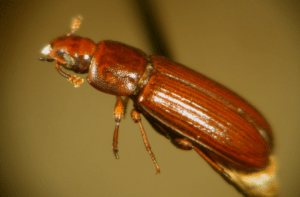
Flour bugs (also known as pantry weevils) are tiny beetles that typically live in your kitchen, and feed on the dry food in your pantry.
Whether it be Flour, cereal, cake mix, noodles, crackers, or bread, any of these options are favorites for these tiny creatures.
But unlike other pests that eat dry goods in your pantry (similar to cockroaches), these small bugs can really eat. Flour bugs will also mate while they eat, and then lay eggs right in your pantry around the food source.
Though these insects can be confused with bed bugs, they are actually quite different. Unlike bed bugs, these insects will not typically infest areas like the bedroom or around furniture.
Where these insects are most similar is that they get into your home through hitchhiking. While bed bugs will stow away in your luggage or clothes, flour beetles will lay eggs on a wheat kernel in the field, survive the milling process, and end up in bags of flower that you buy at the grocery store.
Bed Bug Size
Let’s quickly take a look at the size of bed bugs.
The average adult bed bug ranges from ¼ – ½ inch in length. Their size is very much dependent on whether they have had a recent meal.
For example:
A bed bug that has recently fed will be more balloon-like, with a reddish-brown tint, and can be above ½ inch in length.
A bed bug that has not fed recently will be flat, brown, and more difficult to see with the naked eye.
Below is a breakdown of the average size of bed bugs relative to other bugs.
(From biggest to smallest)
| Type of Insect | Size (inches) |
|---|---|
| Mosquitos | 0.4 Inches |
| Bed Bugs | 0.33 Inches |
| Cockroaches | 0.25 Inches |
| Bat Bugs | 0.23 Inches |
| Swallow Bugs | 0.18 Inches |
| Wood Ticks | 0.12 Inches |
| Spider Beetles | 0.10 Inches |
| Lice | 0.09 Inches |
| Booklice | 0.06 Inches |
| Fleas | 0.05 Inches |
Can Bed Bugs Fly?
The answer is no….bed bugs do not fly. Bed bugs do not have wings either, but they do have 6 legs, which allows them to crawl a good distance.
It’s important to note that bed bugs can not jump either. Unlike other insects such as fleas, bed bugs don’t have powerful hind legs.
This is one of the reasons why bed bug traps can work to capture bed bugs.
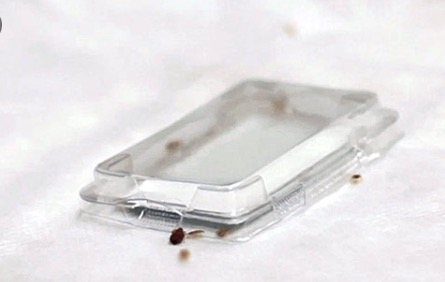
(especially when placed at the foot of the bed).
This all causes people to wonder. If bed bugs can’t fly, jump, or run…
How are they able to travel and spread around the world?
These pests can transport themselves rapidly by hitchhiking on humans and their belongings. Whether it be clothes, bags, or somewhere on the human body, bed bugs are avid travelers.
These creatures have made a major resurgence lately, which is why the country is currently experiencing a bed bug epidemic.
Think you were bitten by bed bugs? Click here to learn how to properly diagnose a bed bug bite.
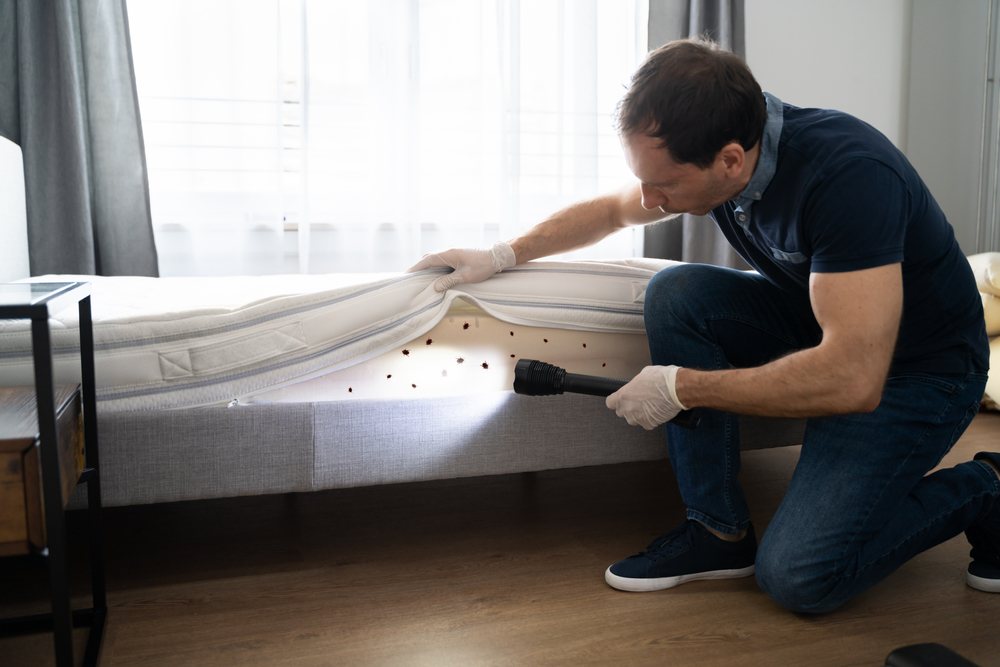

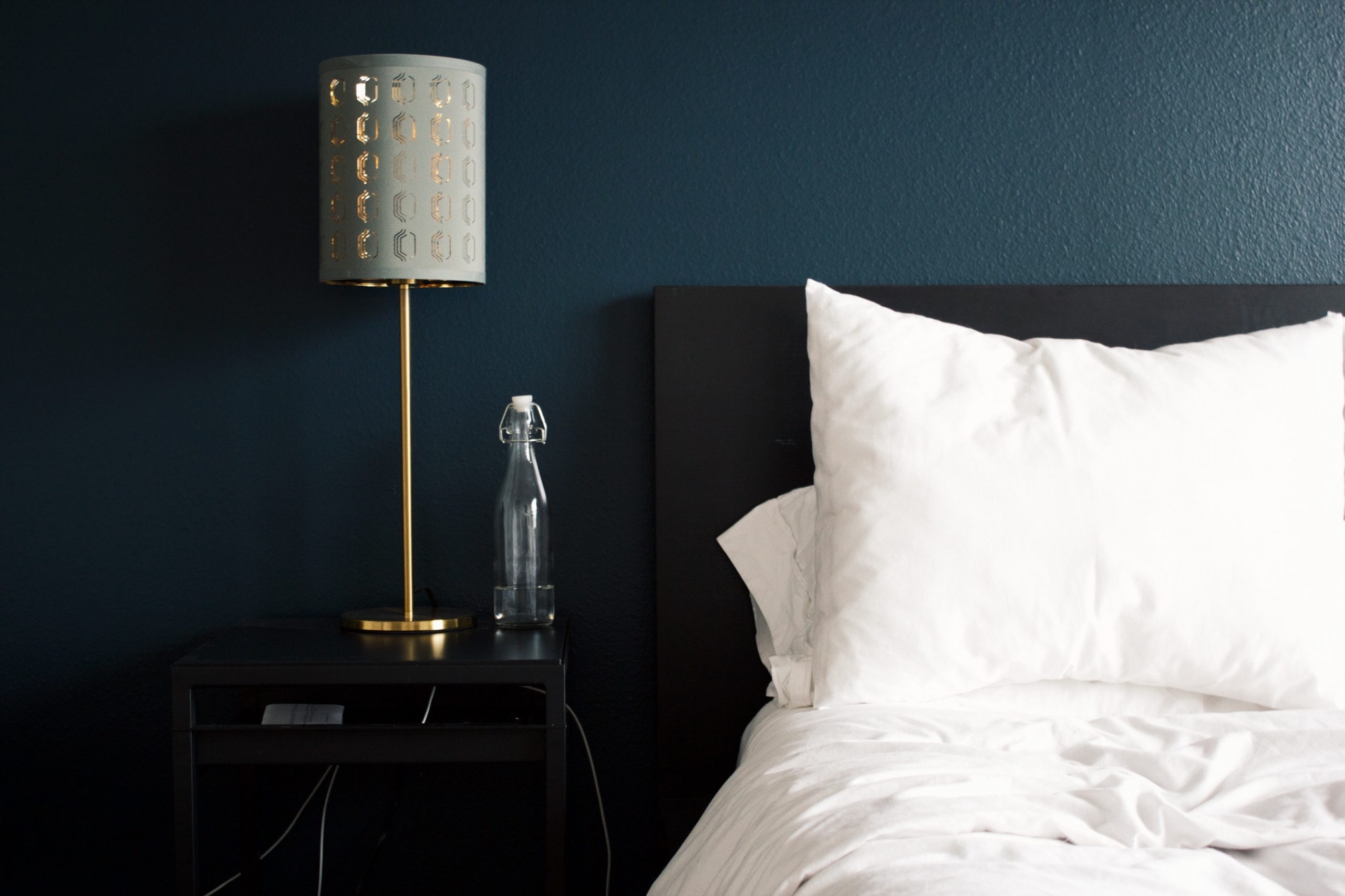


Thanks for this post Robert – Me and my husband stayed at the quality inn and suites in Waycross Georgia. On 2 occasions we noticed bugs walking across the carpet and immediately thought the room was infested with bed bugs. Turned out they were actually Carpet Beatles in the end.. Very gross but still better than bed bugs!
I’m staying in a hotel and I videotaped the bugs and I have bites on my arms,I went to the hospital and I got conformation
We moved in to the eagle ranch apt complex and it was infested with bed bugs and spiders in called 3 days after we moved in and told them about the bugs and they accused us of bringing them with us to the apartment complex we have a new mattress and box spring and they are covered in plastic and we have brand new furniture and it’s getting ruined from the bugs i called them again and again they told us we had to pay$500 dollars for the exterminator to come in and do the apartment and $100 for them to come look at wat i had put in a plastic sandwich bag i told them i wasn’t paying for anything cause this place wasn’t cleaned and theses things were already here cause they were in the door frames going up the wall if we would have brought them it wouldn’t have been like that in every room and closets in 3 days they said they would send some one that day they never came and there trying to say that out Apt has been sprayed 3 times already which that’s a lie as well cause I’m always home I’m on disability i have a tumor in my spine so i stay home alot unless I’m with my friend which hasn’t been often cause i don’t want to give her theses things cause she has a new born so they left a letter on my door saying if we don’t get rid of theses bugs were going to be evicted this isn’t fair we’ve tried everything and I’m getting ate up every night and I’m tired of my body hurting from this crap I’m to embarrassed to go to the hospital and tell them cause i don’t want people to think I’m a nasty person who has a filthy house this is so embarrassing i swear i take 3 shower a day the only time i feel clean is in the shower thank u for reading this
Crazy. Are there any other bugs that bite specifically like bed bugs? I’m a landlord trying to provide my tenants with some education surrounding bed bugs (how to prevent/deal with an infestation etc.) Any additional resources you have?
I wonder if they are any more bugs. I feel like my apartment building is full of bugs and every time I see one I’m worried it’s a bed bug lol
I’m not sure what it is but I have a terrible rash all over my legs. Sometimes I see black pepper like specs on bed and in living room. The only bug like thing I’ve ever seen is a white spongy like bug about the size of a rice grain. Sometimes I see white or tan hard little things about the size of a grain of sand. Still don’t know what what’s causing my red itchy scaly bumps rash on legs. A few bumps are infected due to scratching. I have very sensitive skin. Doctors DO NOT HELP other than “take antihistamines”. PLEASE HELP. I’ve done lots of online research but nothing conclusive. I’m elderly and disabled and on low income disability and CANNOT AFFORD EXTERMINATOR. PLEASE PLEASE HELP
Do you have any pets by any chance? I had the black pepper/rice grain sometimes too, it turns out my cat had some sort of fleas.
TRY DIATOMACEOUS EARTH…Its a white powder sort of thing like flour nd you spread it (I used a broad paint brush…)Its INEXPENSIVE about $8 A BAG and is not harmful like many of the chemicals used to treat infestations…
Vicki, your situation sounds like fleas. The larvae look like white sand and the eggs look like black dots. They tend to bite the lower leg area and for the unfortunate few of us, itch like heck.
I just found a single bug on my upper arm that looks like a bed bug, but is much darker. I ended up squashing it between a sheet of paper and think it may have drew blood (but no red trace). Looking at the different images, it looks like it may have been a tick. I have a dog, but have never seen ticks on him (I live in the city and inspect him regularly). If a tick, I don’t know where it would have come from (had showered and was in clean clothes). I have a tiny small bump from the bite (doesn’t itch), and not sure how concerned to be. (Infestation, infection, proper identification.) Thoughts?
I have a strange little dots that connect together some of them seem like hairs and they move in almost a fuzz pattern across the floor furniture,my skin, are in the walls and attacking my dogs. They start out like little white boring worms almost. They move throughout the floor together and appear to be a solid dense moving scuff marks on the wall. Doctors think I’m crazy but they’re very mean and painful please help
You should video
Then with your phone for
Proof
Lori! I feel your pain! This same type of thing is happening to me!
Found this bug upside down on toilet seat this evening. Def fell from ceiling fan in Apt building with 6 floors. I am on the 3rd. What is it? Can I send a pic?
Woke this morning and found a single bug on top of a cover that I’d used to transport some furniture about 5 days ago. I washed everything in hot water and turned my room upside down but was unable to find another bug like the one I saw on the cover. Flipped the mattress- no nests or bed bugs. Can I send a pic ?
bed bug bites are usually most located around the head, neck, and arms as these areas are where the carbon dioxide from breathing is most concentrated. they are attracted to this and body warmth and during sleeping they have an excellent opportunity to zero in on these areas. After feeding, bed bugs seek to hide in tight, enclosed spaces to digest their meal for a few days before feeding again. they are flat so can get in impossibly thin crevices usually in a 6 to 8′ radius from the bed. In large infestations, they will spread throughout the home. The can live in bed lamps, behind wall sockets and between bed supports at the joints making difficult to eradicate them with a bug bomb. early and small infestations can be gotten under control DIY with diluted rubbing alcohol sprayed in every crack and on the carpets and furniture, but it’s always best to hire a reputable pest company as they have tools and better insecticides.
hope this helps someone!
Curious did anyone come
About ?
Can someone please give me a call I have a few bug questions 14802776652